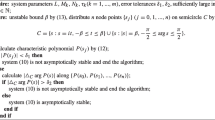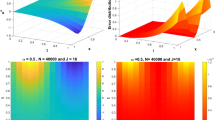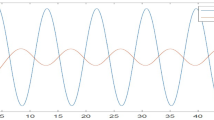Abstract
Optimal model reduction for large-scale linear dynamical systems is studied. In contrast to most existing works, the systems under consideration are not required to be stable, neither in discrete nor in continuous time. As a consequence, the underlying rational transfer functions are allowed to have poles in general domains in the complex plane. In particular, this covers the case of specific conservative partial differential equations such as the linear Schrödinger and the undamped linear wave equation with spectra on the imaginary axis. By an appropriate modification of the classical continuous time Hardy space \(\varvec{\mathcal {H}}_{\varvec{2}}\), a new \(\varvec{\mathcal {H}}_{\varvec{2}}\)-like optimal model reduction problem is introduced and first-order optimality conditions are derived. As in the classical \(\varvec{\mathcal {H}}_{\varvec{2}}\) case, these conditions exhibit a rational Hermite interpolation structure for which an iterative model reduction algorithm is proposed. Numerical examples demonstrate the effectiveness of the new method.
Similar content being viewed by others
Data Availability
The code used for this paper is available in https://github.com/aaborghi/H2-arbitrary-domains.
References
Antoulas, A.C.: Approximation of large-scale dynamical systems. Society for Industrial and Applied Mathematics, Philadelphia (2005). https://doi.org/10.1137/1.9780898718713
Gugercin, S., Antoulas, A.C., Beattie, C.: \(\cal{H} _2\) model reduction for large-scale linear dynamical systems. SIAM J. Matrix Anal. Appl. 30(2), 609–638 (2008). https://doi.org/10.1137/060666123
Meier, L., Luenberger, D.G.: Approximation of linear constant systems. IEEE Trans. Autom. Control 12, 585–588 (1967). https://doi.org/10.1109/TAC.1967.1098680
Mullis, C.T., Roberts, R.A.: Synthesis of minimum roundoff noise fixed point digital filters. IEEE Trans. Circ. Syst. 23(9), 551–562 (1976). https://doi.org/10.1109/TCS.1976.1084254
Moore, B.C.: Principal component analysis in linear systems: controllability, observability, and model reduction. IEEE Trans. Autom. Control 26(1), 17–32 (1981). https://doi.org/10.1109/TAC.1981.1102568
Barrault, M., Maday, Y., Nguyen, N.C., Patera, A.T.: An ‘empirical interpolation’ method: application to efficient reduced-basis discretization of partial differential equations. Comptes Rendus Math 339(9), 667–672 (2004). https://doi.org/10.1016/j.crma.2004.08.006
Rozza, G., Huynh, D.B.P., Patera, A.T.: Reduced basis approximation and a posteriori error estimation for affinely parametrized elliptic coercive partial differential equations. Arch. Comput. Methods Eng. 15, 229–275 (2008). https://doi.org/10.1007/s11831-008-9019-9
Grimme, E.J.: Krylov projection methods for model reduction. Ph.D. Thesis, University of Illinois, Urbana-Champaign, Urbana, IL (1997)
Freund, R.W.: Model reduction methods based on Krylov subspaces. Acta Numer. 12, 267–319 (2003). https://doi.org/10.1017/S0962492902000120
Mayo, A.J., Antoulas, A.C.: A framework for the solution of the generalized realization problem. Linear Algebra Appl. 425(2), 634–662 (2007). https://doi.org/10.1016/j.laa.2007.03.008. (Special Issue in honor of Paul Fuhrmann)
Sirovich, L.: Turbulence and the dynamics of coherent structures, parts I. II and III. Q. Appl. Math. 45(3), 561–590 (1987). https://doi.org/10.1090/qam/910462
Kunisch, K., Volkwein, S.: Galerkin proper orthogonal decomposition methods for parabolic problems. Numer. Math. 90(1), 117–148 (2001). https://doi.org/10.1007/s002110100282
Brunton, S.L., Proctor, J.L., Kutz, J.N.: Discovering governing equations from data by sparse identification of nonlinear dynamical systems. Proc National Acad. Sci. 113(15), 3932–3937 (2016). https://doi.org/10.1073/pnas.1517384113
Kutz, J.N., Brunton, S.L., Brunton, B.W., Proctor, J.L.: Dynamic mode decomposition. Society for Industrial and Applied Mathematics, Philadelphia, PA (2016). https://doi.org/10.1137/1.9781611974508
Peherstorfer, B., Willcox, K.: Data-driven operator inference for nonintrusive projection-based model reduction. Comput. Methods Appl. Mech. Eng. 306, 196–215 (2016). https://doi.org/10.1016/j.cma.2016.03.025
Hesthaven, J.S., Rozza, G., Stamm, G.: Certified reduced basis methods for parametrized partial differential equations. Springer, Cham, Switzerland (2015). https://doi.org/10.1007/978-3-319-22470-1
Benner, P., Ohlberger, M., Cohen, A., Willcox, K.: Model reduction and approximation. Society for Industrial and Applied Mathematics, Philadelphia, PA (2017). https://doi.org/10.1137/1.9781611974829
Benner, P., Mehrmann, V., Sorensen, D.C.: Dimension reduction of large-scale systems. Springer, Berlin, Germany (2005). https://doi.org/10.1007/3-540-27909-1
Wilson, D.A.: Optimum solution of model-reduction problem. Proc. Inst. Electr. Eng. 117(6), 1161–1165 (1970). https://doi.org/10.1049/piee.1970.0227
Van Dooren, P., Gallivan, K.A., Absil, P.-A.: \(\cal{H} _2\)-optimal model reduction of MIMO systems. App. Math. Lett. 21(12), 1267–1273 (2008). https://doi.org/10.1016/j.aml.2007.09.015
Van Dooren, P., Gallivan, K.A., Absil, P.-A.: \(\cal{H} _2\)-optimal model reduction with higher-order poles. SIAM J. Matrix Anal. Appl. 31(5), 2738–2753 (2010). https://doi.org/10.1137/080731591
Bunse-Gerstner, A., Kubalinska, D., Vossen, G., Wilczek, D.: \(h_2\)-norm optimal model reduction for large scale discrete dynamical MIMO systems. J. Comput. Appl. Math. 233(5), 1202–1216 (2010). https://doi.org/10.1016/j.cam.2008.12.029
Anić, B., Beattie, C., Gugercin, S., Antoulas, A.C.: Interpolatory weighted-\(\cal{H} _2\) model reduction. Autom. 49(5), 1275–1280 (2013). https://doi.org/10.1016/j.automatica.2013.01.040
Breiten, T., Beattie, C., Gugercin, S.: Near-optimal frequency-weighted interpolatory model reduction. Syst. Control Lett. 78, 8–18 (2015). https://doi.org/10.1016/j.sysconle.2015.01.005
Petersson, D., Löfberg, J.: Model reduction using a frequency-limited \(\cal{H} _2\)-cost. Syst. Control Lett. 67, 32–39 (2014). https://doi.org/10.1016/j.sysconle.2014.02.004
Gugercin, S., Polyuga, R.V., Beattie, C.A., van der Schaft, A.J.: Interpolation-based \(\cal{H} _2\) model reduction for port-Hamiltonian systems. In: Proceedings of the 48h IEEE Conference on Decision and Control, pp. 5362–5369. (2009). https://doi.org/10.1109/CDC.2009.5400626
Baur, U., Beattie, C.A., Benner, P., Gugercin, S.: Interpolatory projection methods for parameterized model reduction. SIAM J. Sci. Comput. 33(5), 2489–2518 (2011). https://doi.org/10.1137/090776925
Beattie, C.A., Gugercin, S.: Realization-independent \(\cal{H}_2\)-approximation. In: Proceedings of the 51st IEEE Conference on Decision and Control (2012). https://doi.org/10.1109/CDC.2012.6426344
Magruder, C., Beattie, C., Gugercin, S.: Rational Krylov methods for optimal \(\cal{L}_2\) model reduction. In: 49th IEEE Conference on Decision and Control (CDC), pp. 6797–6802 (2010). https://doi.org/10.1109/CDC.2010.5717454
Sinani, K., Gugercin, S.: \(\cal{H} _2(t_f)\) optimality conditions for a finite-time horizon. Autom. 110, 108604 (2019). https://doi.org/10.1016/j.automatica.2019.108604
Kubalinska, D.: Optimal interpolation-based model reduction. Ph.D. Thesis, Universitaet Bremen, Bremen, Germany (2008)
Mlinarić, P., Gugercin, S.: \(\cal{L}_2\)-optimal reduced-order modeling using parameter-separable forms (2022). arXiv:2206.02929
Mlinarić, P., Gugercin, S.: A unifying framework for interpolatory \(\cal{L}_2\)-optimal reduced-order modeling (2023). arXiv:2209.00714
De Villemagne, C., Skelton, R.E.: Model reductions using a projection formulation. In: 26th IEEE Conference on Decision and Control vol. 26, pp. 461–466. IEEE, Los Angeles, CA, USA (1987). https://doi.org/10.1109/CDC.1987.272862
Wegert, E.: Visual complex functions. Springer, Basel, Switzerland (2012). https://doi.org/10.1007/978-3-0348-0180-5
Freitag, E., Busam, R.: Complex analysis. Springer, Berlin Heidelberg (2009). https://doi.org/10.1007/978-3-540-93983-2
Kythe, P.K.: Handbook of conformal mappings and applications. Chapman and Hall/CRC, New York (2019). https://doi.org/10.1201/9781315180236
Beliaev, D.: Conformal maps and geometry. World Scientific (Europe), London (2019). https://doi.org/10.1142/q0183
Duren, P.L.: Theory of H\(^{\text{p}}\) spaces. Academic Press, New York and London (1970). https://doi.org/10.1016/S0079-8169(08)62674-4
Bradley, R.E., Petrilli, S.J., Sandifer, C.E.: L’Hôpital’s Analyse des Infiniments Petits. Birkhäuser, Cham, Switzerland (2015). https://doi.org/10.1007/978-3-319-17115-9
Antoulas, A.C., Beattie, C.A., Gugercin, S.: Interpolatory methods for model reduction. Society for Industrial and Applied Mathematics, Philadelphia, PA (2020). https://doi.org/10.1137/1.9781611976083
Trefethen, L.N.: Approximation theory and approximation practice. Society for Industrial and Applied Mathematics, Philadelphia, PA (2019). https://doi.org/10.1137/1.9781611975949
Tucsnak, M., Weiss, G.: Observation and control for operator semigroups. Birkhäuser Basel, Basel (2009). https://doi.org/10.1007/978-3-7643-8994-9
Acknowledgements
We would like to thank Olivier Sète, Jan Zur, and Mathias Oster for their insightful and helpful discussions.
Funding
Funded by the Deutsche Forschungsgemeinschaft (DFG, German Research Foundation) - 384950143 as part of GRK2433 DAEDALUS.
Author information
Authors and Affiliations
Corresponding author
Ethics declarations
Conflict of interest
The authors declare no competing interests.
Additional information
Publisher's Note
Springer Nature remains neutral with regard to jurisdictional claims in published maps and institutional affiliations.
Rights and permissions
Springer Nature or its licensor (e.g. a society or other partner) holds exclusive rights to this article under a publishing agreement with the author(s) or other rightsholder(s); author self-archiving of the accepted manuscript version of this article is solely governed by the terms of such publishing agreement and applicable law.
About this article
Cite this article
Borghi, A., Breiten, T. \(\mathcal {H}_2\) optimal rational approximation on general domains. Adv Comput Math 50, 28 (2024). https://doi.org/10.1007/s10444-024-10125-8
Received:
Accepted:
Published:
DOI: https://doi.org/10.1007/s10444-024-10125-8




